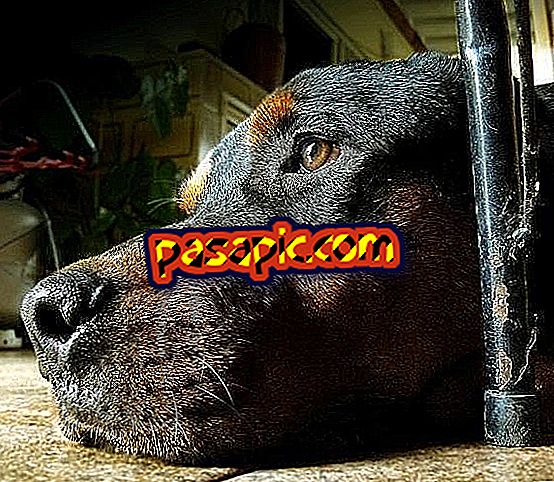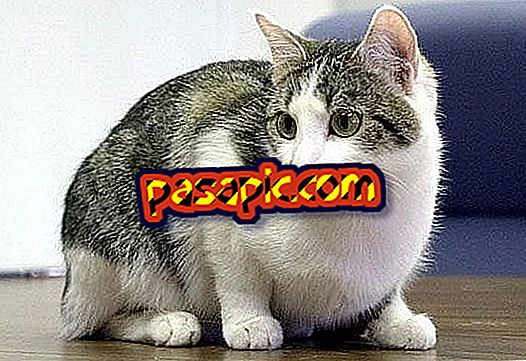How to cure canine parvovirus

Parvovirus or canine parvovirus is a very common disease in dogs, especially during the first months of life. The parvo virus is usually fatal if it is not identified and treated in time, and even more so when it happens in puppies. If you notice that your dog vomits frequently, does not eat, has lost a lot of weight or makes bloody stools, take it to the veterinarian immediately to perform the relevant tests.
If you want more information about this disease, in this article we explain how to cure the canine parvovirus so you know what to do in case your can contract it.
one
If you think your dog has parvovirus, the first thing you should do is take your dog to the veterinarian to diagnose the type of disease he has. Once diagnosed, the first reaction is usually to fight dehydration ; For this, the dog is given a dose of serum that your veterinarian must stipulate depending on his condition.
two
Normally, the veterinarian performs a replacement fluid therapy, that is, administration of serum to rehydrate the dog. The fluids that compose it are the isotonic crystalloids (the most suitable to fight the parvo is the Ringer-Lactato, according to the veterinarians), which can be combined with colloids, such as hydroxyalmidon or dextran. This treatment is usually administered intravenously.
In severe cases in which the parvo virus results in cardiac or renal problems such crystalloids should be administered with extreme care, as they can not tolerate them with the same success as a can with normal cardiac and renal functions.

3
The rate and amount of administration of the serum will be stipulated by the veterinarian based on the size and weight of the dog and the development of the disease. In addition to fluid therapy, canine parvovirus is combated by blood transfusions .
Due to the bloody diarrhea that the parvo virus produces, the dog loses a lot of blood and needs to recover, in addition to renewing it to get rid of the virus little by little. In both puppies and adult dogs, the donor must be a healthy, adult dog and must have all required vaccinations.
4
With serum to rehydrate and blood transfusions the parvovirus sick dog begins to recover and replace each of the deficits produced by the virus. Once rehydrated, the veterinarian will continue with maintenance fluid therapy, which is usually composed of an isotonic glucosaline solution supplemented with potassium chloride.
However, fluids may vary depending on the patient's condition. It will always be the veterinarian who determines which are the most appropriate, the amounts and rhythm of administration. In many cases, the parvovirus can cause a state of hypokalemia, or other imbalances, and the dog should receive potassium to recover properly.

5
If you do not want to have your dog admitted, there is the possibility of administering the treatment at home using serum backpacks (first those of rehydration and then those of maintenance). Normally, the veterinarian usually complements fluid therapy with antibiotics and antiemetics, which he must prescribe himself and detail all the information related to the intake (quantity and time).
If you treat your dog at home, you must go on the days that the veterinarian indicates to your consultation to perform a check on the progress and development of the patient. Of course, the first dose of replacement fluid therapy and blood transfusions will be performed at the veterinary hospital.
If you treat it at home you must have all the objects (blankets, bed, etc.) and place where you have your dog completely clean and disinfected. Remember that the parvo virus can live in extreme situations for months.
6
It is important to emphasize that, although this is the most effective treatment, the same effect does not have to arise in all patients, since the state of the disease and the dog itself have a lot to do with it. In puppies it is usually more critical and, often, they require complementary medicines that help them improve their defenses, because the virus leaves them very weakened.
And, sometimes, it is also possible for the veterinarian to provide you with a homemade serum so you can give it to yourself at home (do not use a serum on your own without first consulting a professional). It is essential that you go to your veterinarian to start treatment and fight the canine parvovirus.

7
Every time there are more cases that resort to Tamiflu to fight the parvovirus for its optimal results. It is a specific medication to treat the flu virus. The dose should be 2ml per kilo, this means that if your dog weighs 10kg you should give him 20ml. A dose should be provided daily, for 10 days, always at the same time.
Tamiflu is complementary to veterinary treatment, by itself it will not do anything. Consult with a specialist before giving it to your dog. Also, although it has been successful in many cases, it does not mean that it can eliminate the parvo in all the dogs, because each dog presents some concrete reactions.
8
To know if your dog has parvovirus it is important that you know the symptoms of this disease, something that can help you to detect the health of your dog. The parvovirus directly affects the gastrointestinal system of the animal causing symptoms such as the following:
- Fever
- Little encouragement
- Gasping, panting breathing
- Lack of appetite in the dog
- Sparkling nausea and vomiting
- Diarrhea with blood and a very strong odor
- Dehydration of the dog
If you notice that your dog has any of these symptoms, take it immediately to the veterinarian, especially if it is a puppy because it can cause sudden death.

9
You should know that you can avoid parvovirus in a dog by following a series of recommendations regarding health and hygiene. In we give you a list of tips that you can follow to protect your dog from this disease:
- Follow the vaccination plan proposed by your veterinarian to the letter.
- Deworm your dog frequently.
- Maintain hygiene both in your dog and in the environment in which he lives.
- Frequently wash the dog's bowl of food and drink.
- Avoid a puppy being in contact with their own feces.
If your dog has been infected with parvovirus and has already recovered, you should know that it is possible that this mite has remained in your home, therefore, it is essential that you disinfect your home parvovirus and thus ensure an optimal space for the life of your dog.


